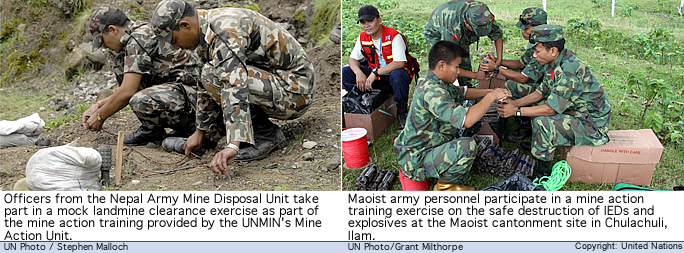|
Reports
on Nepal's Civil War: Landmines
|
|
|
|
United
Nations Mine Action Service UNMAS
|
|
|
United
Nations Mine Action Service (Department of Peacekeeping Operations)
|
 |
|
PORTFOLIO
OF Mine Action Projects
|
 |
| The
use of explosive devices by both parties to the conflict has resulted in
hundreds of deaths and injuries annually, both to combatants and to civilians. |
|
Initial
research indicates that the majority of casualties are due to an extensive
use of improvised explosive devices (IEDs) by the Communist Party of Nepal
(Maoist) (CPN-M), rather than to mines and IEDs used by the security forces.
However, should the conflict cause large-scale movements of people, the
number of mine casualties could rise significantly.
Nepal
is not a signatory to the 1997 antipersonnel mine-ban treaty, although
the government did announce in June 2004, that it would form a committee
to examine the issues involved. Nepal is also not a signatory to the
1980 Convention on Certain Conventional Weapons.
Two
nongovernmental organisations (NGOs) are collecting data:
the
Informal Sector Service Centre (INSEC)
and
the
Nepal Campaign to Ban Landmines (NCBL)
According
to INSEC's Nepal: Human Rights Yearbook 2005, 289 people were killed by
explosions in 2004, another 674 were injured, and another 52 reported to
have been "terrified.� NCBL's data for the same period gives a figure of
389 people being killed by explosions (mines, ambush, IEDs) and 1,056 injured.
Socket
bombs (improvised hand grenades) tend to be the key post-engagement
unexploded ordnance (UXO) causing risk to civilian populations. CPN-M also
makes use of larger IEDs such as pressure-cooker bombs, which have been
used to target buildings, pylons, telecom towers and other structures,
as well as in roadside ambushes of military and civilian vehicles, including
buses and ambulances.
Most
devices appear to be detonated on command through use of timers, radio
signals or other devices. Very few devices used by the CPN-M appear to
be victim activated.
The
security forces have also been reported to be laying mines as defensive
perimeters around military installations and infrastructure such as
bridges, dams and pylons, as well as around potential vantage points above
military installations. There are concerns that mines laid around structures
on high ground, might be subject to landslides.
The
government has claimed that the Royal Nepal Army (RNA) has planted mines
only around army posts using safety procedures and using adequate marking.
However, there are counterclaims that the RNA does not always fence the
area, does not always notify the local villagers of this threat, does not
always mark the mine field and if it moves on, does not always detonate,
disable or remove the mines before leaving.
Source:
PORTFOLIO OF Mine Action Projects 2006, Ninth Edition
Published
by
United
Nations Mine Action Service (Department of Peacekeeping Operations)
|
International
Mine Action Standards for Mine Risk Education
|
 |
 |
| UNICEF
entered into a partnership with the Geneva International Centre for Humanitarian
Demining to develop this series of twelve Best Practice Guidebooks.
The primary aim of these Guidebooks is to provide advice, tools and guidance
to undertake mine risk education programmes that are compliant with International
Mine Action Standards. They are also intended to provide a framework for
a more predictable, systematic and integrated approach to mine risk education.
They will be useful to anyone engaged in planning, managing, funding or
evaluating mine risk education programmes and projects. |
|
|
Source:
International Mine Action Standards for Mine Risk Education

|








